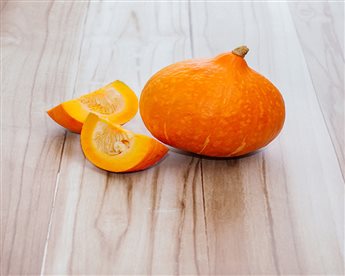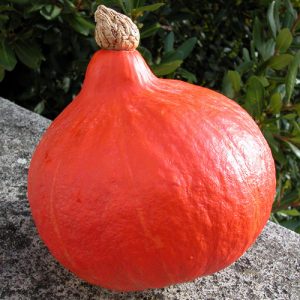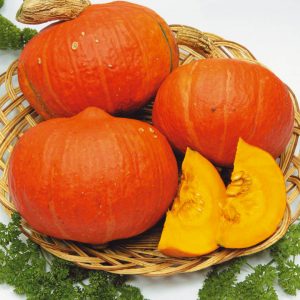Delicious and bright pumpkin "Kapitoshka": we get acquainted with the variety and the reviews of gardeners about its cultivation
Pumpkin is a tasty and healthy vegetable crop, unpretentious in cultivation and fruitful. Its nutmeg varieties captivate even the most fastidious gourmets and culinary experts with their honey aroma. Among the most interesting varieties refers to Kapitoshka.
From the article you will learn how Kapitoshka differs from other varieties, how to grow and store this crop, what are its advantages and disadvantages, and what farmers say about it.
The content of the article
Description of pumpkin variety
Kapitoshka is the juiciest and sweetest of the butternut pumpkin varieties... It has a pleasant honey aroma, for which it received the second name Honey Princess.
Distinctive features
 Its unusual appearance due to its decorative segmented shape and bright orange color makes it an adornment of personal plots and distinguishes it from other varieties of butternut squash.
Its unusual appearance due to its decorative segmented shape and bright orange color makes it an adornment of personal plots and distinguishes it from other varieties of butternut squash.
The culture is unpretentious and not demanding in care, it has a high immunity to the most common and dangerous diseases of melons.
Fruit characteristics
It is a climbing crop with rounded, slightly flattened fruits, divided into distinct segments. The peel is thin. The peduncle is pentahedral, widening towards the base. Seeds are yellowish-brown in color.
The pulp is dense, sugary, bright yellow or orange, with a high content of carotene. The fruits have a distinct sweet, honey taste.
The mass of a standard fruit is 3-4 kg, it can reach up to 10 kg. Ripening lasts 4-4.5 months, during which time the required amount of sweetness and vitamins is collected.
Yield
The variety is mid-season, has a high yield, subject to all the rules of care and cultivation. It lies well and does not lose its presentation for a long time. During storage, the pumpkin turns brown.
How to grow
The quality of the planting material, correct planting and the fulfillment of all care requirements affect growth and yield.
Planting by seeds or seedlings

For planting, it is preferable to choose freshly harvested seeds. Suitability can be determined by placing them in a container with water for 1 hour - floating seeds are discarded. Seeds that have mechanical damage, signs of mold, yellowness, diseases are also not suitable.
To kill the pathogenic microflora, before planting, the seeds are heated at 40 ° C for 9 hours, and then etched for half an hour in a weak solution of potassium permanganate.
The planting method depends on the local climate. In the southern regions, seeds are sown immediately in open ground... In the middle and central lane, as well as in the northern regions, they use seedling growing method.
Open field seed planting technology:
- 2 weeks before sowing the seeds, the soil is fertilized with humus (1 bucket per 1 m² of soil), dug up and leveled;
- at a distance of 100-150 cm from each other, pits are dug 4-6 cm deep;
- each hole is watered and 2-3 seeds are placed, covered with earth and irrigated, you can cover with a film until shoots appear;
- after emergence, the film is removed;
- 1-2 of the strongest sprouts are left, if 2 seedlings are left, then their shoots are sent in opposite directions.
The timing of sowing seeds for seedling cultivation is determined individually, based on the climate of a particular area.Necessary conditions - heating of open ground by the time of planting at least 12 ° C at a depth of 10 cm, the age of the seedlings should not exceed 25-30 days.
Seedling technology:
- sediment containers are filled with a nutrient composition (preferably garden soil mixed with compost or humus);
- place seeds, sprinkle with soil, lightly crush, irrigate, cover with film or glass and put in a warm place;
- during the development of seedlings, it is necessary to ensure a stable temperature of 23-25 ° C, moderate humidity, regular ventilation and irrigation;
- the first shoots appear in 14-20 days, after which the shelter is removed, the seedlings continue to be watered periodically.
Transplanting into open ground is carried out after the end of the spring frost. The sprouts should have 3 leaves each - this is a prerequisite for transplanting.
Care
Pumpkin Kapitoshka is an unpretentious culture, but loves timely care.
 Regular watering of the plant promotes intensive development, lush flowering and rich fruiting. Water as the soil dries up, no more than twice a week. During the formation of buds and ovaries, the frequency of watering is increased.
Regular watering of the plant promotes intensive development, lush flowering and rich fruiting. Water as the soil dries up, no more than twice a week. During the formation of buds and ovaries, the frequency of watering is increased.
So that an earth crust does not form on the surface around the plant, after each watering, the soil should be loosened and weeds removed.
The bush is formed taking into account the climate conditions in which it develops. In severe conditions, no more than two ovaries are left on one plant; in the regions of the middle and central strip, three or four fruits can be left on one lash. In southern latitudes, the formation of bushes is not carried out. To prevent fruitful shoots from losing their strength, all branches without ovaries are completely removed.
Reference. To prevent new fruits from forming over existing ones, the shoots are pinched behind the fifth leaf.
For additional feeding of the bushes and preventing the soil from drying out, peat or humus is introduced under the central stem. The pumpkin is not demanding for feeding, it is enough to fertilize it with a mullein diluted with water. This is done once before the leaves appear and during flowering, then two or three more times.
If the pumpkin grows on sandy loam soil, it is fertilized with a mixture of superphosphates, wood ash and humus. In loamy soil, fertilizers from a mixture of potassium, superphosphate, wood ash and ammonium nitrate are added to the holes (20 g of phosphorus and 10 g of nitrate are taken for 200 g of ash).
Features of cultivation and possible difficulties
Honey pumpkin varieties do not like clay soil - keep this in mind when choosing a planting site.
It is impossible to disturb the root system of the plant, therefore, the seedlings are transplanted from a separate container into open ground along with a lump of earth.
The formation of bushes can create difficulties, since the variety is very climbing. For large and tasty fruits, make sure that no more than three ovaries remain on the shoot.
Growing tips from experienced gardeners
Several important recommendations:
- experienced gardeners advise taking only freshly harvested pumpkin seeds for planting;
- if the summer is short, then the pumpkin is grown in seedlings;
- during the ripening period, it is better to completely abandon watering the plant, otherwise there is a danger of fruit rotting;
- do not loosen the soil too deeply to damage the roots;
- you can still remove green fruits - the variety will ripen and gain sweetness at home in 1-1.5 months.
Diseases and pests
The variety is resistant to diseases, but if you do not follow the rules of care, the pumpkin can suffer from powdery mildew, fusarium, mosaic. To avoid this, regularly inspect the bush for signs of infection, avoid thickening of the plantings, remove leaves that block sunlight.
Sick plants are treated with copper sulphate or Bordeaux mixture; for prevention, they can be sprinkled with wood ash.
For aphids, spider mites and caterpillars, use a garlic infusion, a solution of soap and ash, and a tincture of hot pepper.
Harvesting and application of the crop
Harvest after the plant stems begin to dry out. Cut the pumpkins, leaving tails at least 10 cm long... When temporarily outdoors, cut pumpkins are protected from sunlight. To prevent the fruits from rotting, do not allow them to come into contact with each other.
In winter, the pumpkin is stored in cool, well-ventilated rooms with low humidity levels, at temperatures from 5 to 15 ° C. Compliance with optimal conditions contributes to the preservation of fruits for 5-7 months.
Kapitoshka pumpkin is used for making pureed soups, cereals and casseroles, as fillings for pies. Can be eaten raw in salads and juices, dry and wither. It has a beneficial effect on digestion, improves metabolism, strengthens the immune system, helps to cope with insomnia and depression. It has dietary properties and is suitable for feeding infants.
Advantages and disadvantages of the variety
Kapitoshka has many advantages:
- sweet and juicy pulp;
- unusual ribbed shape;
- large fruits;
- unpretentiousness and ease of growing;
- good keeping quality, long-term preservation of useful properties;
- disease resistance.
Disadvantages of the variety:
- bushes are large, long-leaved, require a lot of space;
- poor tolerance to direct sunlight;
- in the temperate zone there is a rather long period of full ripening, the maximum sweetness can be gained only in late autumn.
Farmers reviews
According to farmers' reviews, the cultivation of a pumpkin variety is not difficult, and adherence to simple care rules always guarantees a good harvest.
Larisa, Novorossiysk: “I like the pumpkin very much: the fruits are beautiful, as in the picture, segmented. In terms of volume, they promise a lighter pumpkin. In reality, the fruits are heavy. The flesh layer is thick, sweet. The skin is easy to clean, thin. "
Leonid, Mytischi:“During storage, it does not dry out and does not rot, it can lie until May. There are few seeds in the variety. I left it on purpose to collect it for landing. "
Conclusion
Both experienced gardeners and beginners can grow the Kapitoshka variety. A good harvest of pumpkin is a guarantee of a supply of vitamins for the entire winter. This is a treasure trove of useful microelements that have a beneficial effect on human health.